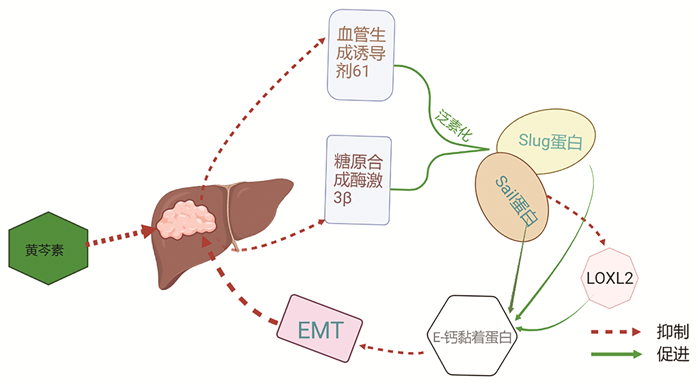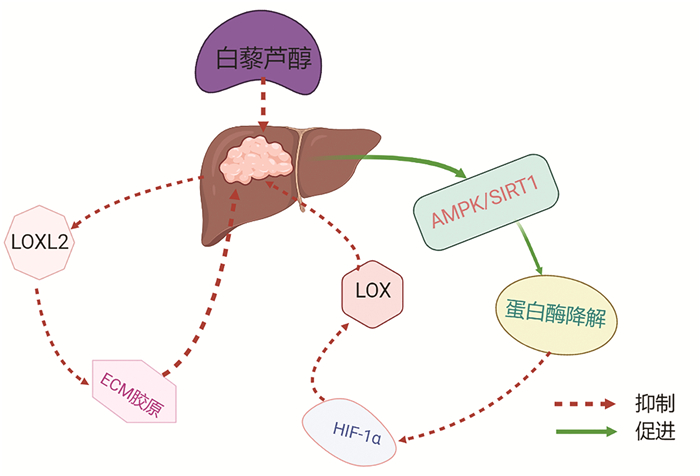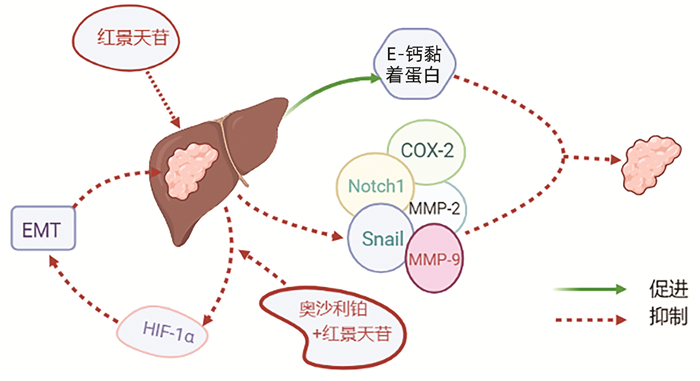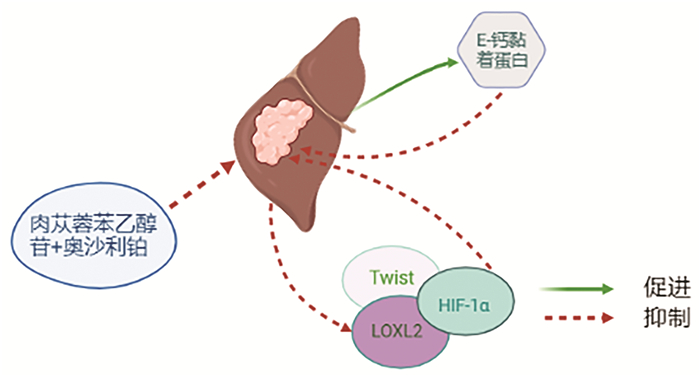| [1] |
Professional Committee for Prevention and Control of Hepatobiliary and Pancreatic Diseases of Chinese Preventive Medicine Association; Professional Committee for Hepatology, Chinese Research Hospital Association; Chinese Society of Hepatology, Chinese Medical Association, et al. Guideline for stratified screening and surveillance of primary liver cancer (2020 edition)[J]. J Clin Hepatol, 2021, 37(2): 286-295. DOI: 10.3969/j.issn.1001-5256.2021.02.009. |
| [2] |
VANNUCCI L. Stroma as an active player in the development of the tumor microenvironment[J]. Cancer Microenviron, 2015, 8(3): 159-166. DOI: 10.1007/s12307-014-0150-x. |
| [3] |
PINNELL SR, MARTIN GR. The cross-linking of collagen and elastin: Enzymatic conversion of lysine in peptide linkage to alpha-aminoadipic-delta-semialdehyde (allysine) by an extract from bone[J]. Proc Natl Acad Sci U S A, 1968, 61(2): 708-716. DOI: 10.1073/pnas.61.2.708. |
| [4] |
TENTI P, VANNUCCI L. Lysyl oxidases: Linking structures and immunity in the tumor microenvironment[J]. Cancer Immunol Immunother, 2020, 69(2): 223-235. DOI: 10.1007/s00262-019-02404-x. |
| [5] |
JUNG ST, KIM MS, SEO JY, et al. Purification of enzymatically active human lysyl oxidase and lysyl oxidase-like protein from Escherichia coli inclusion bodies[J]. Protein Expr Purif, 2003, 31(2): 240-246. DOI: 10.1016/s1046-5928(03)00217-1. |
| [6] |
GRIMSBY JL, LUCERO HA, TRACKMAN PC, et al. Role of lysyl oxidase propeptide in secretion and enzyme activity[J]. J Cell Biochem, 2010, 111(5): 1231-1243. DOI: 10.1002/jcb.22845. |
| [7] |
MOLNAR J, FONG KS, HE QP, et al. Structural and functional diversity of lysyl oxidase and the LOX-like proteins[J]. Biochim Biophys Acta, 2003, 1647(1-2): 220-224. DOI: 10.1016/s1570-9639(03)00053-0. |
| [8] |
WATERHOUSE A, BERTONI M, BIENERT S, et al. SWISS-MODEL: Homology modelling of protein structures and complexes[J]. Nucleic Acids Res, 2018, 46(W1): w296-w303. DOI: 10.1093/nar/gky427. |
| [9] |
BIENERT S, WATERHOUSE A, de BEER TA, et al. The SWISS-MODEL Repository-new features and functionality[J]. Nucleic Acids Res, 2017, 45(D1): d313-d319. DOI: 10.1093/nar/gkw1132. |
| [10] |
GUEX N, PEITSCH MC, SCHWEDE T. Automated comparative protein structure modeling with SWISS-MODEL and Swiss-PdbViewer: A historical perspective[J]. Electrophoresis, 2009, 30 Suppl 1: s162-s173. DOI: 10.1002/elps.200900140. |
| [11] |
STUDER G, REMPFER C, WATERHOUSE AM, et al. QMEANDisCo-distance constraints applied on model quality estimation[J]. Bioinformatics, 2020, 36(6): 1765-1771. DOI: 10.1093/bioinformatics/btz828. |
| [12] |
BERTONI M, KIEFER F, BIASINI M, et al. Modeling protein quaternary structure of homo-and hetero-oligomers beyond binary interactions by homology[J]. Sci Rep, 2017, 7(1): 10480. DOI: 10.1038/s41598-017-09654-8. |
| [13] |
ZHU J, HUANG S, WU G, et al. Lysyl oxidase is predictive of unfavorable outcomes and essential for regulation of vascular endothelial growth factor in hepatocellular carcinoma[J]. Dig Dis Sci, 2015, 60(10): 3019-3031. DOI: 10.1007/s10620-015-3734-5. |
| [14] |
SALGADO R, BENOY I, BOGERS J, et al. Platelets and vascular endothelial growth factor (VEGF): A morphological and functional study[J]. Angiogenesis, 2001, 4(1): 37-43. DOI: 10.1023/a:1016611230747. |
| [15] |
DONG Y, XIE X, WANG Z, et al. Increasing matrix stiffness upregulates vascular endothelial growth factor expression in hepatocellular carcinoma cells mediated by integrin β1[J]. Biochem Biophys Res Commun, 2014, 444(3): 427-432. DOI: 10.1016/j.bbrc.2014.01.079. |
| [16] |
WANG Y, ZHANG X, WANG W, et al. Integrin αVβ5/Akt/Sp1 pathway participates in matrix stiffness-mediated effects on VEGFR2 upregulation in vascular endothelial cells[J]. Am J Cancer Res, 2020, 10(8): 2635-2648.
|
| [17] |
YUAN R, LI Y, YANG B, et al. LOXL1 exerts oncogenesis and stimulates angiogenesis through the LOXL1-FBLN5/αvβ3 integrin/FAK-MAPK axis in ICC[J]. Mol Ther Nucleic Acids, 2021, 23: 797-810. DOI: 10.1016/j.omtn.2021.01.001. |
| [18] |
FAN Z, ZHENG W, LI H, et al. LOXL2 upregulates hypoxia-inducible factor-1α signaling through Snail-FBP1 axis in hepatocellular carcinoma cells[J]. Oncol Rep, 2020, 43(5): 1641-1649. DOI: 10.3892/or.2020.7541. |
| [19] |
UMANA-DIAZ C, PICHOL-THIEVEND C, MARCHAND MF, et al. Scavenger Receptor Cysteine-Rich domains of Lysyl Oxidase-Like2 regulate endothelial ECM and angiogenesis through non-catalytic scaffolding mechanisms[J]. Matrix Biol, 2020, 88: 33-52. DOI: 10.1016/j.matbio.2019.11.003. |
| [20] |
LI R, WANG Y, ZHANG X, et al. Exosome-mediated secretion of LOXL4 promotes hepatocellular carcinoma cell invasion and metastasis[J]. Mol Cancer, 2019, 18(1): 18. DOI: 10.1186/s12943-019-0948-8. |
| [21] |
YAN L, XU F, DAI CL. Relationship between epithelial-to-mesenchymal transition and the inflammatory microenvironment of hepatocellular carcinoma[J]. J Exp Clin Cancer Res, 2018, 37(1): 203. DOI: 10.1186/s13046-018-0887-z. |
| [22] |
HAPKE RY, HAAKE SM. Hypoxia-induced epithelial to mesenchymal transition in cancer[J]. Cancer Lett, 2020, 487: 10-20. DOI: 10.1016/j.canlet.2020.05.012. |
| [23] |
UMEZAKI N, NAKAGAWA S, YAMASHITA YI, et al. Lysyl oxidase induces epithelial-mesenchymal transition and predicts intrahepatic metastasis of hepatocellular carcinoma[J]. Cancer Sci, 2019, 110(6): 2033-2043. DOI: 10.1111/cas.14010. |
| [24] |
WANG M, ZHAO X, ZHU D, et al. HIF-1α promoted vasculogenic mimicry formation in hepatocellular carcinoma through LOXL2 up-regulation in hypoxic tumor microenvironment[J]. J Exp Clin Cancer Res, 2017, 36(1): 60. DOI: 10.1186/s13046-017-0533-1. |
| [25] |
CUEVAS EP, MORENO-BUENO G, CANESIN G, et al. LOXL2 catalytically inactive mutants mediate epithelial-to-mesenchymal transition[J]. Biol Open, 2014, 3(2): 129-137. DOI: 10.1242/bio.20146841. |
| [26] |
HU Q, MASUDA T, KURAMITSU S, et al. Potential association of LOXL1 with peritoneal dissemination in gastric cancer possibly via promotion of EMT[J]. PLoS One, 2020, 15(10): e0241140. DOI: 10.1371/journal.pone.0241140. |
| [27] |
LAURENTINO TS, SOARES R, MARIE S, et al. LOXL3 function beyond amino oxidase and role in pathologies, including cancer[J]. Int J Mol Sci, 2019, 20(14): 3587. DOI: 10.3390/ijms20143587. |
| [28] |
WU Y, GE G. Complexity of type Ⅳ collagens: From network assembly to function[J]. Biol Chem, 2019, 400(5): 565-574. DOI: 10.1515/hsz-2018-0317. |
| [29] |
FANG M, PENG CW, YUAN JP, et al. Coevolution of the tumor microenvironment revealed by quantum dot-based multiplexed imaging of hepatocellular carcinoma[J]. Future Oncol, 2013, 9(7): 1029-1037. DOI: 10.2217/fon.13.63. |
| [30] |
WONG CC, TSE AP, HUANG YP, et al. Lysyl oxidase-like 2 is critical to tumor microenvironment and metastatic niche formation in hepatocellular carcinoma[J]. Hepatology, 2014, 60(5): 1645-1658. DOI: 10.1002/hep.27320. |
| [31] |
BARKER HE, BIRD D, LANG G, et al. Tumor-secreted LOXL2 activates fibroblasts through FAK signaling[J]. Mol Cancer Res, 2013, 11(11): 1425-1436. DOI: 10.1158/1541-7786.MCR-13-0033-T. |
| [32] |
XING X, WANG Y, ZHANG X, et al. Matrix stiffness-mediated effects on macrophages polarization and their LOXL2 expression[J]. FEBS J, 2021, 288(11): 3465-3477. DOI: 10.1111/febs.15566. |
| [33] |
TAN HY, WANG N, ZHANG C, et al. Lysyl oxidase-like 4 fosters an immunosuppressive microenvironment during hepatocarcinogenesis[J]. Hepatology, 2021, 73(6): 2326-2341. DOI: 10.1002/hep.31600. |
| [34] |
BUSNADIEGO O, GONZÁLEZ-SANTAMARÍA J, LAGARES D, et al. LOXL4 is induced by transforming growth factor β1 through Smad and JunB/Fra2 and contributes to vascular matrix remodeling[J]. Mol Cell Biol, 2013, 33(12): 2388-2401. DOI: 10.1128/MCB.00036-13. |
| [35] |
CONTENTE S, KENYON K, SRIRAMAN P, et al. Epigenetic inhibition of lysyl oxidase transcription after transformation by ras oncogene[J]. Mol Cell Biochem, 1999, 194(1-2): 79-91. DOI: 10.1023/a:1006913122261. |
| [36] |
CSISZAR K, FONG SF, UJFALUSI A, et al. Somatic mutations of the lysyl oxidase gene on chromosome 5q23.1 in colorectal tumors[J]. Int J Cancer, 2002, 97(5): 636-642. DOI: 10.1002/ijc.10035. |
| [37] |
KANEDA A, WAKAZONO K, TSUKAMOTO T, et al. Lysyl oxidase is a tumor suppressor gene inactivated by methylation and loss of heterozygosity in human gastric cancers[J]. Cancer Res, 2004, 64(18): 6410-6415. DOI: 10.1158/0008-5472.CAN-04-1543. |
| [38] |
NILSSON M, ADAMO H, BERGH A, et al. Inhibition of lysyl oxidase and lysyl oxidase-like enzymes has tumour-promoting and tumour-suppressing roles in experimental prostate cancer[J]. Sci Rep, 2016, 6: 19608. DOI: 10.1038/srep19608. |
| [39] |
ZHENG Y, WANG X, WANG H, et al. Expression of the lysyl oxidase propeptide in hepatocellular carcinoma and its clinical relevance[J]. Oncol Rep, 2014, 31(4): 1669-1676. DOI: 10.3892/or.2014.3044. |
| [40] |
NARESHKUMAR RN, SULOCHANA KN, CORAL K. Inhibition of angiogenesis in endothelial cells by Human Lysyl oxidase propeptide[J]. Sci Rep, 2018, 8(1): 10426. DOI: 10.1038/s41598-018-28745-8. |
| [41] |
WU G, GUO Z, CHANG X, et al. LOXL1 and LOXL4 are epigenetically silenced and can inhibit ras/extracellular signal-regulated kinase signaling pathway in human bladder cancer[J]. Cancer Res, 2007, 67(9): 4123-4129. DOI: 10.1158/0008-5472.CAN-07-0012. |
| [42] |
CHOI SK, KIM HS, JIN T, et al. LOXL4 knockdown enhances tumor growth and lung metastasis through collagen-dependent extracellular matrix changes in triple-negative breast cancer[J]. Oncotarget, 2017, 8(7): 11977-11989. DOI: 10.18632/oncotarget.14450. |
| [43] |
JOERGER AC, FERSHT AR. The p53 pathway: Origins, inactivation in cancer, and emerging therapeutic approaches[J]. Annu Rev Biochem, 2016, 85: 375-404. DOI: 10.1146/annurev-biochem-060815-014710. |
| [44] |
SHAO J, LU J, ZHU W, et al. Derepression of LOXL4 inhibits liver cancer growth by reactivating compromised p53[J]. Cell Death Differ, 2019, 26(11): 2237-2252. DOI: 10.1038/s41418-019-0293-x. |
| [45] |
BIE B, SUN J, GUO Y, et al. Baicalein: A review of its anti-cancer effects and mechanisms in Hepatocellular Carcinoma[J]. Biomed Pharmacother, 2017, 93: 1285-1291. DOI: 10.1016/j.biopha.2017.07.068. |
| [46] |
NGUYEN LT, SONG YW, CHO SK. Baicalein inhibits epithelial to mesenchymal transition via downregulation of Cyr61 and LOXL-2 in MDA-MB231 breast cancer cells[J]. Mol Cells, 2016, 39(12): 909-914. DOI: 10.14348/molcells.2016.0243. |
| [47] |
LI X, LI J, WANG L, et al. The role of metformin and resveratrol in the prevention of hypoxia-inducible factor 1α accumulation and fibrosis in hypoxic adipose tissue[J]. Br J Pharmacol, 2016, 173(12): 2001-2015. DOI: 10.1111/bph.13493. |
| [48] |
MOHSENI R, ARAB SADEGHABADI Z, GOODARZI MT, et al. Co-administration of resveratrol and beta-aminopropionitrile attenuates liver fibrosis development via targeting lysyl oxidase in CCl 4-induced liver fibrosis in rats[J]. Immunopharmacol Immunotoxicol, 2019, 41(6): 644-651. DOI: 10.1080/08923973.2019.1688829. |
| [49] |
LU L, LIU S, DONG Q, et al. Salidroside suppresses the metastasis of hepatocellular carcinoma cells by inhibiting the activation of the Notch1 signaling pathway[J]. Mol Med Rep, 2019, 19(6): 4964-4972. DOI: 10.3892/mmr.2019.10115. |
| [50] |
QIN Y, LIU HJ, LI M, et al. Salidroside improves the hypoxic tumor microenvironment and reverses the drug resistance of platinum drugs via HIF-1α signaling pathway[J]. EBioMedicine, 2018, 38: 25-36. DOI: 10.1016/j.ebiom.2018.10.069. |
| [51] |
HU Q, YOU SP, LIU T, et al. An investigation on the anti-liver cancer effect of cistanche[J]. Carcinog Teratogenesis Mutagen, 2018, 30(3): 194-199. DOI: 10.3969/j.issn.1004-616x.2018.03.006. |
| [52] |
WEN L, HU J, ZHANG J, et al. Phenylethanol glycosides from Herba Cistanche improve the hypoxic tumor microenvironment and enhance the effects of oxaliplatin via the HIF-1α signaling pathway[J]. Mol Med Rep, 2021, 24(1): 517. DOI: 10.3892/mmr.2021.12156. |



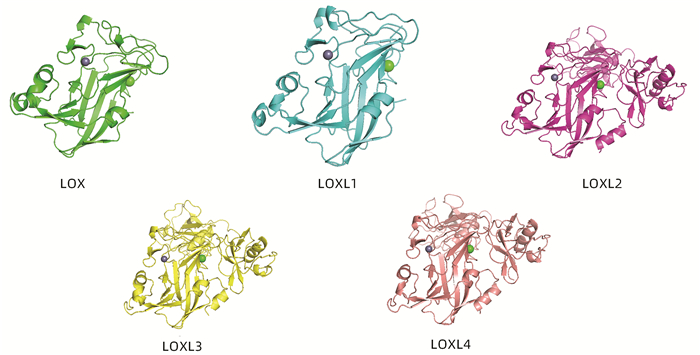




 DownLoad:
DownLoad:
